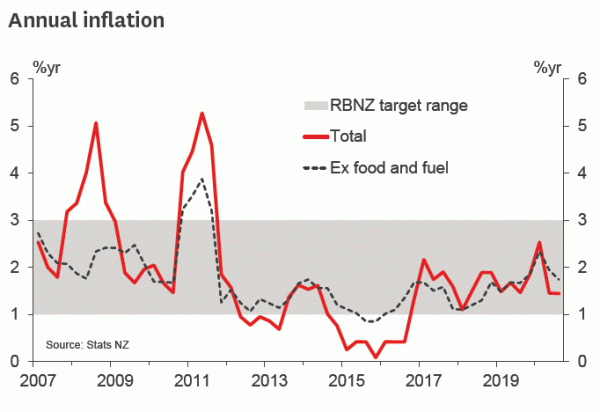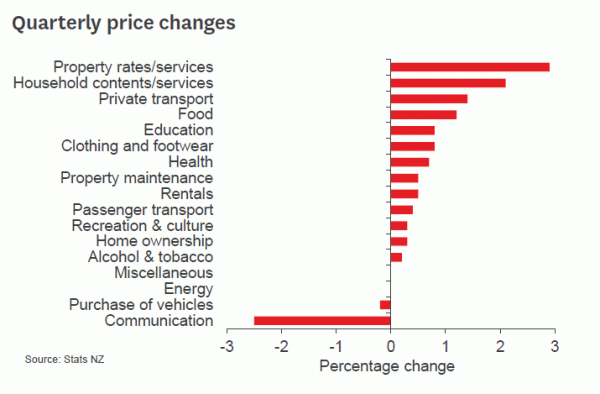- The Consumer Prices Index (CPI) rose 0.7% in the September quarter, led by food, fuel and local body rates.
- The result was lower than we and the Reserve Bank expected. This reinforces the RBNZ’s existing stance that the risks to inflation are all to the downside.
- We continue to expect further monetary easing measures, starting with a bank funding scheme to be announced in November.
Consumer prices rose by 0.7% in the September quarter, with the annual inflation rate dipping slightly from 1.5% to 1.4%. The various measures of ‘core’ inflation (which try to adjust for volatile items) told a similar story, with the annual pace slowing slightly but remaining within the Reserve Bank’s 1-3% target range.
The quarterly increase was less than both we and the market expected. For us, the surprise occurred across a range of items, though with no particular theme emerging. As such, we haven’t made any changes to our forecasts for the next few quarters.
The result was also substantially below the Reserve Bank’s forecast of 1.1%, reinforcing the RBNZ’s stance that the risks to the inflation outlook are all to the downside. Although the economy has bounced back rapidly from the Covid-19 lockdown, it is still operating well below its previous trend, and both we and the RBNZ expect inflation to slow further in the near term. We continue to expect the RBNZ to announce a Funding for Lending Programme for banks, aimed at driving interest rates even lower, at next month’s Monetary Policy Statement
Details.
September is normally a strong quarter for the CPI, with seasonal increases in food prices and the annual increase in local body rates. As such, the 0.7% rise for the quarter was a relatively subdued one (just 0.3% in seasonally adjusted terms).
The September quarter saw a reversal of many of the Covid disruptions that affected the June quarter, in terms of both actual prices and their measurement. This went both ways: public transport that had been made free during the April lockdown has now returned to full price, while domestic airfares, which rose sharply when airlines were operating under Covid restrictions, are now closer to normal.
Some Covid-related disruptions were still apparent in the September quarter. Vegetables prices rose more than usual – some plantings were delayed during the April lockdown, which meant that crops weren’t available at their usual time. The effect on the CPI will fade fairly quickly.
Prices for household goods were higher than we expected on balance. That’s in line with recent anecdotes of firms having trouble importing stock due to supply chain disruptions. However, the effect on prices wasn’t particularly strong, and probably manifested more as a lack of discounting rather than outright price hikes.
The housing-related components were relatively subdued. Rents rose by 0.5%, a smaller increase compared to recent quarters. There was a rent freeze on existing tenancies up to the end of September, although that probably had only a small impact on overall rents (as they could still be increased for new tenancies).
Prices for newly-built homes rose by just 0.3%. This series tends to follow the trend in house sale prices with a lag, so with the housing market running red-hot in recent months we expect that new home prices will soon follow.
The most substantial drop was in the communications category. Mobile phone prices, which had been reported as rising sharply in the two previous quarters, corrected lower this quarter. Services such as broadband, which make up most of the communications group, were broadly flat.
This quarter included the three-yearly update of the CPI weights. The most significant change was a large increase in the weights for rents and new home prices (together making up 18.9% of the index), while airfares have understandably been downgraded. We’ve confirmed that the reweighting doesn’t move the dial on our inflation forecasts for the next few quarters.
Looking ahead, we expect annual inflation to soften further in the near term. While Covid-19 represents a shock to both demand and supply, we think that the effects will be disinflationary on balance. The annual inflation rate is also likely to drop by around 0.3% from early next year due to the end of the jumbo-sized annual increases in tobacco excise. That on its own is not something that the RBNZ should be responding to, but it could make it harder to lift people’s inflation expectations from their already low levels















